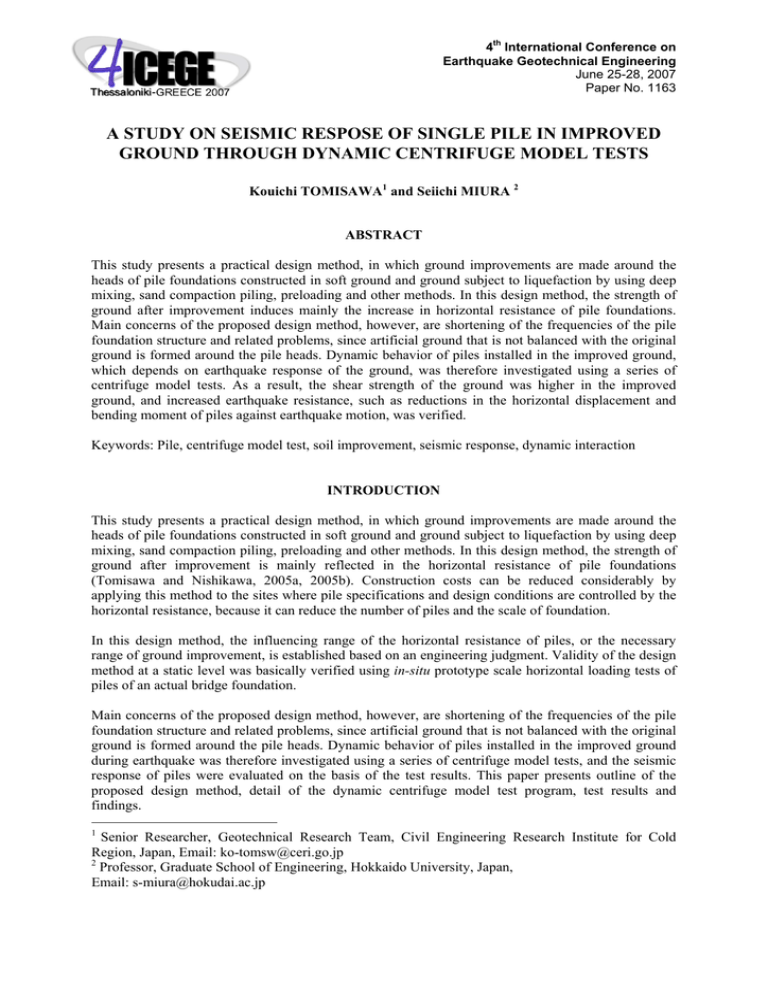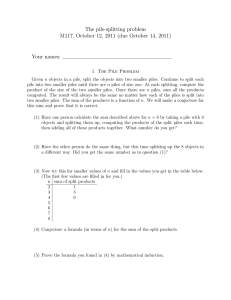A STUDY ON SEISMIC RESPOSE OF SINGLE PILE IN IMPROVED
advertisement

4th International Conference on Earthquake Geotechnical Engineering June 25-28, 2007 Paper No. 1163 A STUDY ON SEISMIC RESPOSE OF SINGLE PILE IN IMPROVED GROUND THROUGH DYNAMIC CENTRIFUGE MODEL TESTS Kouichi TOMISAWA1 and Seiichi MIURA 2 ABSTRACT This study presents a practical design method, in which ground improvements are made around the heads of pile foundations constructed in soft ground and ground subject to liquefaction by using deep mixing, sand compaction piling, preloading and other methods. In this design method, the strength of ground after improvement induces mainly the increase in horizontal resistance of pile foundations. Main concerns of the proposed design method, however, are shortening of the frequencies of the pile foundation structure and related problems, since artificial ground that is not balanced with the original ground is formed around the pile heads. Dynamic behavior of piles installed in the improved ground, which depends on earthquake response of the ground, was therefore investigated using a series of centrifuge model tests. As a result, the shear strength of the ground was higher in the improved ground, and increased earthquake resistance, such as reductions in the horizontal displacement and bending moment of piles against earthquake motion, was verified. Keywords: Pile, centrifuge model test, soil improvement, seismic response, dynamic interaction INTRODUCTION This study presents a practical design method, in which ground improvements are made around the heads of pile foundations constructed in soft ground and ground subject to liquefaction by using deep mixing, sand compaction piling, preloading and other methods. In this design method, the strength of ground after improvement is mainly reflected in the horizontal resistance of pile foundations (Tomisawa and Nishikawa, 2005a, 2005b). Construction costs can be reduced considerably by applying this method to the sites where pile specifications and design conditions are controlled by the horizontal resistance, because it can reduce the number of piles and the scale of foundation. In this design method, the influencing range of the horizontal resistance of piles, or the necessary range of ground improvement, is established based on an engineering judgment. Validity of the design method at a static level was basically verified using in-situ prototype scale horizontal loading tests of piles of an actual bridge foundation. Main concerns of the proposed design method, however, are shortening of the frequencies of the pile foundation structure and related problems, since artificial ground that is not balanced with the original ground is formed around the pile heads. Dynamic behavior of piles installed in the improved ground during earthquake was therefore investigated using a series of centrifuge model tests, and the seismic response of piles were evaluated on the basis of the test results. This paper presents outline of the proposed design method, detail of the dynamic centrifuge model test program, test results and findings. 1 Senior Researcher, Geotechnical Research Team, Civil Engineering Research Institute for Cold Region, Japan, Email: ko-tomsw@ceri.go.jp 2 Professor, Graduate School of Engineering, Hokkaido University, Japan, Email: s-miura@hokudai.ac.jp HORIZONTAL RESISTANCE EVALUATION OF PILES INSTALLED IN IMPROVED GROUND Setting the range of ground improvement In the case of horizontal resistance of piles, the limit equilibrium state is considered to be maintained because the front ground of piles will be compressed in the horizontal direction and horizontal reaction earth pressure will therefore increase, if the maximum value of horizontal subgrade reaction is treated as the limit resistance proportional to the horizontal loading (e.g. Matsuo and Tominaga, 2002). Thus, the range of horizontal resistance formed in the front ground of piles when horizontal loading is applied to piles can be considered as a passive earth pressure area, which is represented as the zone covered by the slip surface of passive failure. In other words, the horizontal behavior of piles where horizontal loading is applied to the pile heads is governed by the properties of ground material within the range of passive failure in front of piles from the characteristic length, 1/β, which is the influencing depth of horizontal resistance of piles. Therefore, in this study, the range of influence depth of the horizontal resistance of piles in improved ground was set as an inverted cone formed with the gradient of the surface of passive failure θ = (45°+φ/2) (φ: internal friction angle of soil) from the depth of the characteristic length of piles, 1/β. As a result, the necessary range of ground improvement is set as a cubic body covering the above inverted cone shape as shown in Figure 1. The setting method for the range of improvement is the same for both single pile and group piles. Also, since the connection between piles and footings is a rigid connection in principle, there are no changes in the range of improvement due to the fixing degree between piles and footing. Figure 1. 3-D image of the horizontal resistance of pile foundation and the setup for the necessary range of ground improvement Determining horizontal subgrade reaction The horizontal resistance of piles is determined by the coefficient of horizontal subgrade reaction k, which is calculated by Eq. (1) (Japan Road Association, 2002a) from the deformation modulus of ground E. Accordingly, the effect of the shear strength S enhanced by ground improvement is evaluated as the degree of increase in the modulus of deformation of ground E in the design of piles to be constructed in improved ground. ⎛ D/β 1 k= αE ⋅ ⎜ ⎜ 0 .3 0. 3 ⎝ ⎞ ⎟ ⎟ ⎠ −3 / 4 (1) Where, k is the coefficient of horizontal subgrade reaction of piles (kN/m3), E is the modulus of deformation of improved ground (kN/m2), α is a compensation coefficient for estimating coefficient of horizontal subgrade reaction, D is the pile diameter (m), β is the characteristic value of piles (kD/4EyI)1/4, Ey is the Young’s modulus of piles (kN/m2) and I is the second moment of area of the pile section (m4). Since the shear strength of improved ground S is determined based on the improvement rate ap when composite ground around piles is formed through deep mixing or sand compaction piling method, the modulus of deformation of ground E is set by converting the increased value of shear strength ΔS into the modulus of deformation E (Public Works Research Center, 1999). In the case of preloading method, the increment of the modulus of deformation due to ground improvement ΔE, is evaluated as equivalent to the increased value of shear strength of the ground ΔC. By reflecting the increased modulus of deformation of the improved ground E to horizontal resistance of piles, it becomes possible to determine relatively larger horizontal subgrade reaction of piles in improved ground that closely reflects to the actual condition than in the case of using the modulus of deformation of the original ground. EARTHQUAKE RESISTANCE OF PILES IN IMPROVED GROUND Dynamic centrifuge model test A series of centrifuge model tests was conducted to investigate both static and dynamic horizontal behavior of piles in improved ground. For the dynamic centrifuge model test, model ground and pile with a scaling ratio of 1:50 were prepared in a steel model container with inner dimensions of L = 700 mm × B = 200 mm × H = 50 mm. A 50G (G: gravitational acceleration) centrifugal acceleration field was adopted for the both the static horizontal loading test and shaking test to satisfy the similarity law on the stress level. Typical scale factors of quantities for converting between model scale and prototype scale are shown in Table 1. Figure 2 shows the setup condition of the model for shaking tests. Model pile with outer diameter D = 10 mm, wall thickness t = 0.2 mm and length L = 400 mm was made and specially finished from steel pipe, and lower end of the model pile was fixed in the model base ground formed with gypsum. A prototype scale steel pile with out diameter D = 500 mm and length L = 20 m was simulated in the centrifugal acceleration field by using this model pile according to the similarity law. Strain gauges were attached to the model pile to measure both axial and bending stress generated along the axis of the pile, and acceleration sensors were installed on the pile head and in the ground to measure the responses of both pile and ground during shaking. A steel block with the weight of 3.92 N (equivalent to 490kN in prototype scale) was fixed to the pile head to simulate the substructure. The static horizontal loading test of pile was conducted using the commonly used displacement control method. Sine and irregular waves were used as the input waves in shaking tests, the acceleration level of input motion in the model was set as 10 m/s2 (equivalent to 20 gal in prototype scale) to simulate the behavior of pile and ground in the small deformation range. To simplify the test conditions and clarify the difference in strength and rigidity of the original and improved ground, a uniform layer of dry kaolin clay was prepared to simulate completely soft ground, and improved ground was prepared by replacing Toyoura sand in the range around pile head instead of kaolin clay to simulate the ground improvement using sand compaction piling method with a high improvement rate. The model ground was prepared by pouring both kaolin clay and Toyoura sand from a certain height to achieve a uniform density. Table 2 illustrates the basic material properties of the model grounds prepared with kaolin clay and Toyoura sand. The range of improved ground with Toyoura sand was set as a cubic body with length and width of 20 cm and height of 10 cm centering around the pile to simulate the range of influencing the horizontal resistance of pile, which was supposed to cover the inverted cone formed with the gradient of the surface of passive failure θ = (45°+φ/2) from the depth of the characteristic length of piles, 1/β, on the basis of the proposed design method. The strength ratio expressed by the cone index qc between kaolin clay and Toyoura sand, which represents the strength of the model grounds, was set as 1:3 at 1 G field (gravitational field) to confirm the qualitative tendency. Table 1. Typical scale factors Scale factors Quantities (Model scale/Prototype scale) σ m /σ p =1/1 Stress ε m /ε p =1/1 Strain δ m /δ p =1/50 Displacement (Length) 2 Force F m /F p =1/50 3 Weight W m /W p =1/50 α m /α p =50/1 Acceleration f m /f p =50/1 Frequence 2 Seepage =1/50 Time: Dynamic t m /t p =1/50 Creep =1/1 Figure 2. Model setup for the dynamic centrifuge tests Table 2. Properties of the model grounds Kaolin Clay Toyoura Sand kN/m3 10.101 15.574 Sand % - 97.3 Silt % 50.3 0.8 Clay % 49.7 1.9 MN/m2 1.0 3.3 Unit Weight Particle Percentage Cone Index qc Static horizontal subgrade reaction From the static horizontal loading test, the relationship between horizontal load acting on the pile head, horizontal displacement of pile at the position of ground surface and bending stress of the pile body was obtained by measuring load, displacement and strains along the axis of the pile during test. Figure 3 shows the distribution of horizontal displacements of pile for the uniform ground of kaolin clay and improved ground with Toyoura sand for each level of horizontal loading. The static coefficient of horizontal subgrade reaction of pile k was calculated backward by the elastic ground reaction method (Japan Road Association, 2002a), on the basis of horizontal load, displacement and bending stress. As a result of the calculation, the static coefficient of horizontal subgrade reaction k at the standard displacement level (equivalent to 1% of the pile diameter) was predicted as k1=775kN/m3 for the uniform ground of kaolin clay. The same coefficient for the improved ground with Toyoura sand was predicted as k2=3090kN/m3, approximately three times large as k1, and roughly corresponded with the ground strength ratio expressed by the cone index qc of the improved ground with Toyoura sand to that of the uniform ground of kaolin clay. This result is considered to support the validity of the proposed design method at a static level. 5 Depth (m) 0 Uniform ground of kaolin clay -5 -10 -15 -0.05 □ Load cycle No.1: p=25.375kN ○ Load cycle No.2: p=50.676kN △ Load cycle No.3: p=73.378kN ◇ Load cycle No.4: p=93.801kN Improved ground with Toyoura sand ■ Load cycle No.1: p=32.288kN ● Load cycle No.2: p=66.979kN ▲ Load cycle No.3: p=97.503kN ◆ Load cycle No.4: p=123.833kN 0.00 0.05 0.10 0.15 Horizontal displacement of the pile δ (m) 0.20 Figure 3. Distribution of horizontal displacement of pile for uniform ground of kaolin clay and improved ground with Toyoura sand drawn form the static loading test Dynamic horizontal behavior of piles in improved ground Figure 4 shows a comparison of the frequency curves for piles between uniform ground of kaolin clay and improved ground with Toyoura sand. These data were obtained from shaking tests using sinewaves with various frequencies. The vertical axis in the figure represents the ratio of Fourier amplitude of the acceleration response at the pile head to that of the input acceleration at the base ground, i.e., the ratio of transfer functions and curve fitting for the frequency curves was performed to remove noise by using a three-order function. As a result, the natural frequency of the pile was found to be 0.95 Hz in the uniform ground of kaolin clay and 1.4 Hz in the improved ground using Toyoura sand. Because the improved ground has greater shear strength, the period of the pile in composite ground becomes shorter. Since the damping effect of the whole bridge system (superstructure and substructure) changes with the shortening of the period (heightening of the frequency) of the pile foundation, careful attention should be paid to the radiation damping phenomenon from the pile foundation to the ground when considering the earthquake resistance of piles in improved ground (Railway Technical Research Institute, 1999). Transfer rate of the ground response relative to the input motion 30 Uniform ground (kaolin clay) Composite ground (Toyoura sand) 20 0.95Hz 1.4Hz 10 0 0.8 1 1.2 Frequency (Hz) 1.4 1.6 Figure 4. Predominant frequency of the pile installed in uniform ground of kaolin clay and improved ground with Toyoura sand Figure 5 illustrates the relationship between the Fourier amplitude and the frequency obtained from the acceleration response measured through accelerometers installed on the pile head, in the center level of the improved ground with Toyoura sand and the original ground of kaolin clay respectively during shaking using irregular white noise waves. As a result, the natural frequencies in model scale were found to be 300 Hz for the improved ground using Toyoura sand (Figure 5(b), f = 6.0 Hz, T = 0.17 sec in prototype scale) and 200 Hz for original kaolin clay ground (Figure 5(c), f = 4.0 Hz, T = 0.25 sec in prototype scale), while that for the pile head was around 60 Hz (Figure 5(a) f = 1.2 Hz, T = 0.83 sec in prototype scale). Comparing with the ground characteristic value TG (natural period of the ground specified by Specifications for Highway Bridges V: Seismic Design, Japan Road Association, 2002b), the improved ground using Toyoura sand is equivalent to Type I ground (TG < 0.2) and the original kaolin clay ground is equivalent to Type II ground (0.2 ≤ TG < 0.6). As a result, it was considered that the improved ground using Toyoura sand and pile did not resonate as an integral structure, and that the pile, improved ground using Toyoura sand and original kaolin clay ground showed different dynamic behavior depending on their respective deformability and response characteristics. Fourier amplitude (gal・sec) Fourier amplitude (gal・sec) Frequency (Hz) (a) Response frequency characteristics of the pile Fourier amplitude (gal・sec) Frequency (Hz) (b) Response frequency characteristics of the improved ground with Toyoura sand Frequency (Hz) (c) Response frequency characteristics of the original ground of kaolin clay Figure 5. Response frequency characteristics of the pile, improved ground with Toyoura sand and original ground of kaolin clay for the test case of composite ground (in model scale) Figures 6 and 7 show the distributions of horizontal displacement and bending moment respectively along the axes of piles installed in the uniform ground of kaolin clay and improved ground with Toyoura sand at a time interval of Δt = 0.1 sec. The data for these figures were obtained during shaking using the sine-waves with natural frequencies of piles as the input motions. The maximum displacement of the piles in the improved ground with Toyoura sand was only 1/6 of that of piles in uniform ground of kaolin clay (δmax for the improved ground / δmax for the uniform ground ≈ 0.0016 m / 0.0107 m). The maximum bending moment occurred within the range of depth 1/β was 1/2.5 of that in uniform ground of kaolin clay (Mmax for the improved ground /Mmax for the uniform ground ≈ 25.2 kN-m / 64.3 kN-m) and converged within the range of improved ground with Toyoura sand. This was considered to be due to the restriction on the pile head in improved ground and the decrease in displacement amplitude of the pile during shaking. As a result, by using ground improvement around the pile head, a certain amount of earthquake resistance that restricts pile displacement and bending moment against earthquake motion was achieved, though careful attention should be paid to the shortening of the natural frequency of pile foundations in improved ground. CONCLUSIONS As a result of verification through dynamic centrifuge model tests, the following findings were obtained concerning the static and dynamic horizontal behavior of piles in improved ground: 1) Static horizontal resistance of piles in improved ground is controlled by material properties of the ground within the range of the characteristic depth of pile 1/β, and the pile displacement and bending moment converge within the range of improved ground. The static coefficient of subgrade reaction k of piles in the improved ground with Toyoura sand calculated from the results of static horizontal loading tests of this study was found to correspond with the ground strength ratio to the uniform ground of kaolin clay. 2) A series of centrifuge shaking tests, showed that the improved ground using Toyoura sand and pile did not resonate as an integral structure and that they showed different dynamic behavior depending on their respective deformability and response characteristics. 3) Owing to the increments of density and strength by ground improvement, the shortening of natural frequency of pile foundation in improved ground need to be carefully noticed. 4) The dynamic centrifuge model tests revealed also that the displacement and bending moment of pile could be controlled depending on the strength of improved ground around pile head, and that earthquake resistance could be enhanced due to the ground improvement. Through a series of dynamic centrifuge model tests, basic data were obtained for the establishment of a rational design method of piles in improved ground using deep mixing, sand compaction piling, preloading and other methods. The authors intend to do further study on this subject and clarify the dynamic behavior of pile foundations under various conditions using numerical and experimental analyses. Uniform ground of kaolin clay (Δt = 0.1sec in prototype scale) t=0.1s t=1.0s t=0.0s t=0.2s t=0.3s t=0.8s t=0.9s t=0.7s t = 0.0 sec t = 0.1 sec t = 0.2 sec t = 0.3 sec t = 0.4 sec t = 0.5 sec t = 0.6 sec t = 0.7 sec t = 0.8 sec t = 0.9 sec t = 1.0 sec -5 D e p th ( m ) δ max = 0.0107 m -10 -15 -0.015 0 t=0.4s t=0.5s t=0.6s -0.010 -0.005 0.000 0.005 0.010 Horizontal displacement of pile δ (m) -5 t=0.0s t=0.6s t=0.2s t=0.7s t=0.1s t=0.3s t=0.5s t=0.4s Depth of the improved ground 1/β D e p th ( m ) 0 Improved ground with Toyoura sand (Δt = 0.1sec in prototype scale) δ max = 0.0016 m t = 0.0 sec t = 0.1 sec t = 0.2 sec t = 0.3 sec t = 0.4 sec t = 0.5 sec t = 0.6 sec t = 0.7 sec -10 0.015 -15 -0.015 -0.010 -0.005 0.000 0.005 0.010 Horizontal displacement of pile δ (m) 0.015 Figure 6. Horizontal displacement of pile during shaking Improved ground with Toyoura sand (Δt = 0.1sec in prototype scale) Uniform ground of kaolin clay (Δt = 0.1sec in prototype scale) 0 0 t=0.0s t=0.9s t=0.2s t=0.8s t=0.3s t=0.4s t=0.7s t=0.6s -5 t=1.0s t = 0.0 sec t = 0.1 sec t = 0.2 sec t = 0.3 sec t = 0.4 sec t = 0.5 sec t = 0.6 sec t = 0.7 sec t = 0.8 sec t = 0.9 sec t = 1.0 sec M max = 64.3kN-m -10 -15 -80 -60 -40 -20 0 20 40 60 Bending moment of pile at different time interval (kN・m) 80 D e p th ( m ) D e p th ( m ) -5 t=0.1s t=0.5s t=0.1s t=0.2s t=0.7s Depth of the improved ground 1/β t=0.0s t=0.3s t=0.4s t=0.5s t=0.6s M max = 25.2 kN-m t = 0.0 sec t = 0.1 sec t = 0.2 sec t = 0.3 sec t = 0.4 sec t = 0.5 sec t = 0.6 sec t = 0.7 sec -10 -15 -80 -60 -40 -20 0 20 40 60 Bending moment of pile at different time interval (kN・m) Figure 7. Bending moment of pile during shaking 80 REFERENCES Tomisawa K. and Nishikawa J. “Pile design method in composite ground formed by deep mixing method,” Journal of Geotechnical Engineering, Japan Society of Civil Engineers, No.799/III-72, pp. 183-193, 2005a. Tomisawa K. and Nishikawa J. “A design method concerning horizontal resistance of piles constructed in improved ground,” 16th International Conference on Soil Mechanics and Geotechnical Engineering, September 12-16, 2005b. e.g., Matsuo M. and Tominaga M. “Earth pressure,” pp. 20-126, Kashima Shuppankai, 1980 (in Japanese). Japan Road Association “Specifications for highway bridges IV: Substructures,” pp.348-465, 2002a. Public Works Research Centre “Deep mixing method in onshore construction – design and construction manual,” pp. 48 -148, 1999. Railway Technical Research Institute “Design criteria for railway structures and instruction manual aseismic design,” pp. 43-48, 1999. Japan Road Association “Specifications for highway bridges V: Seismic design,” pp.48-118, 2002b.








